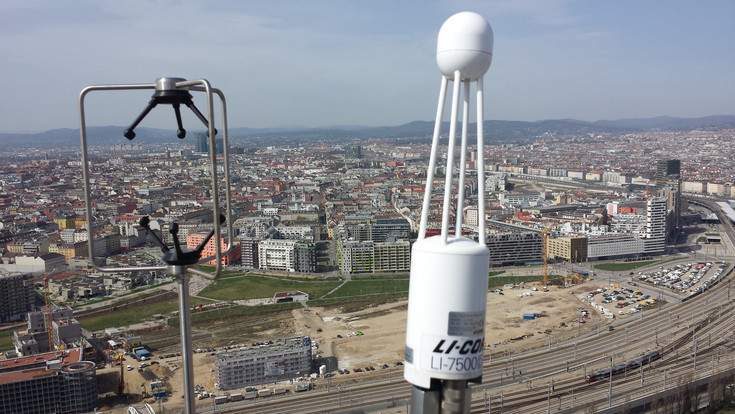02.02.2022 - New method for CO2 monitoring in Vienna on "high level"

In large cities, where there is a particular need for action in terms of climate protection, measurement systems capable of recording local emissions could provide a rapid answer to the question of the effectiveness and accuracy of climate protection measures. In a joint research project, BOKU, Umweltbundesamt (Environment Agency Austria) and A1 Telekom AG tested a method in urban areas for the first time in Vienna that provides real-time data from which correlations with traffic peaks and heating degree days, for example, can be seen.
Since December 2017, the University of Natural Resources and Life Sciences Vienna, Umweltbundesamt (Environment Agency Austria) and A1 Telekom AG have been testing the applicability of a measurement method that has proven itself many times in the case of agricultural areas or forests, also over urban areas. The aim of the research project was to quantify the CO2 emissions of the city of Vienna using the eddy covariance method. In order to be able to cover as large a section of the urban area as possible with one measurement, a correspondingly high measurement altitude is required along with a central location, two characteristics that made the A1 radio tower on the Arsenal site the ideal location. As part of the CarboVienna project, an Eddy Covariance System was installed on the tower's platform at a height of 144 meters above the city, which measures, among other things, CO2 concentration and vertical wind speed at a temporal resolution of 20 measurements per second. "The high measurement frequency of 20 Hertz allows the calculation of half-hourly averages for the vertical turbulent CO2 exchange between the city and the atmospheric boundary layer, which is in equilibrium with the windward net CO2 emissions," explains Helmut Schume from BOKU's Institute of Forest Ecology (IFE).
Rapid information on emissions
The results of the measurements from 2018-2020 have now been published in the journal Atmospheric Environment earlier this year. They show that the Eddy Covariance System does indeed provide a plausible, independent measure of net CO2 emissions from much of the city. The annual values for Vienna calculated from consumption data by Umweltbundesamt experts in the Bundesländer-Luftschadstoffinventur (BLI) were used as a benchmark. Subtracting point sources of CO2 that are outside the covered measurement range, the measured net emissions for 2018 of 10.89 kt CO2 per km² per year were very similar to the most recent BLI value at the time of the evaluation.
"In addition to the rapid availability of results, another added value of the method is the provision of spatial and temporal information on CO2 emissions," emphasizes BOKU researcher and Umweltbundesamt expert Bradley Matthews. The measurement series show a close correlation of emissions with heating degree days, and the diurnal variations on weekdays clearly reflect the morning and evening traffic peaks. In year-to-year comparisons, spring 2020 stands out, when COVID measures led to CO2 emissions from the most densely built-up districts falling by half during the first lockdown.
Scientific basis for targeted measures
A1 CFO Sonja Wallner explains, "We are pleased to be able to contribute to the measurement of CO2 emissions in Vienna by making our infrastructure and expertise available. Reducing CO2 emissions is a key objective of A1. Scientific foundations are the basis for targeted measures."
As part of the follow-up project Vienna Urban Carbon Laboratory, the project partners, with the collaboration of the Technical University of Munich, are now investigating how these and other atmospheric measurement methods can support greenhouse gas monitoring in the city of Vienna.
To the publication:
https://doi.org/10.1016/j.atmosenv.2022.118941
Contact:
Dr. Bradley Matthews, MSc.
Institute of Forest Ecology (IFE), University of Natural Resources and Life Sciences Vienna and Umweltbundesamt, Department of Emission Inventories and Climate Protection
bradley.matthews(at)boku.ac.at
+43 1 47654 - 91 243
A.o. Univ.Prof. Dr. Helmut Schume
Institute of Forest Ecology (IFE)
University of Natural Resources and Life Sciences Vienna
helmut.schume(at)boku.ac.at
+43 1 47654 - 91 214
